Family : Orchidaceae

Text © Prof. Pietro Pavone

English translation by Mario Beltramini
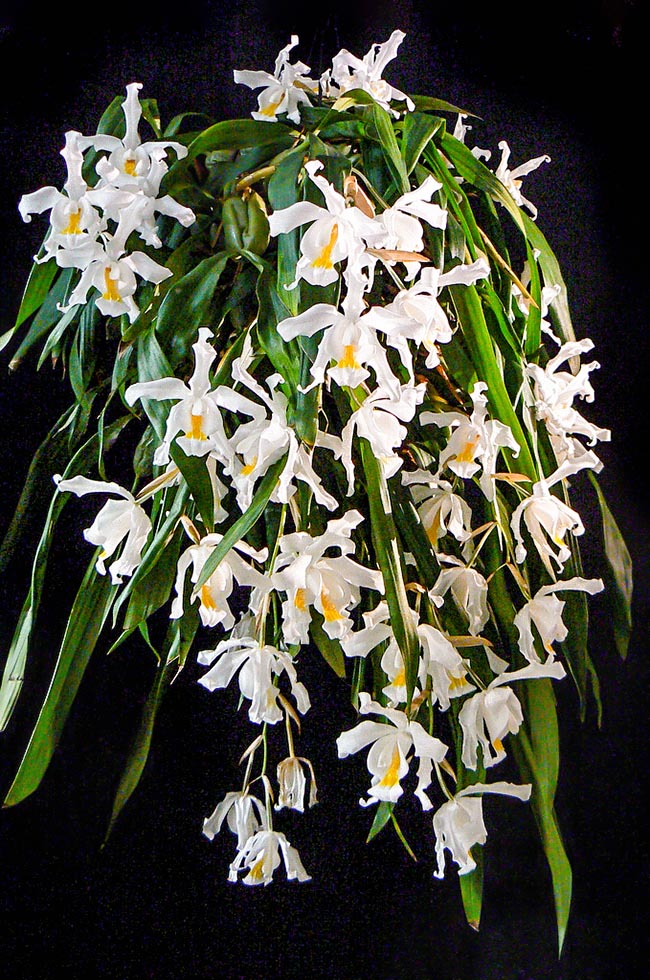
Coelogyne cristsata is a showy orchid native to Assam, India, Bangladesh, Himalaya, Bhutan, Nepal and Tibet © Svetlana Bogatyrev
Coelogyne cristata Lindl. (1824) is a species of the family Orchidaceae, subfamily Epidendroideae, tribe Arethuseae, subtribe Coelogyninae, endemic to South-East Asia.
In particular, it has been found in Assam (India), in Bangladesh, in western and eastern Himalaya, in Bhutan, in Nepal and in Tibet.
It has been reported also on the mountains of Burma (Myanmar) and of northern Thailand but its right determination is not sure.
It grows on the trees and on the rocks, often sunny, in the forests rich in moss, usually from 1600 to 2600 m of altitude.
In winter, many areas are covered by fog or by clouds and the sunlight is much lower.
Yore, its populations were particularly abundant around Darjeeling in the north of India between Bhutan and Nepal.
Sir Joseph Dalton Hooker (1817-1911) British botanist and explorer himself, after his voyage in Antarctica from 1839 to 1843, went to India and on the Himalaya from 1847 to 1851 to collect plants for the Kew Gardens.
In the text of voyage he noted: “During the ascent from Darjeeling the straight stems of many of the timber trees are literally covered by a continuous coat of white flowered Coelogyne, that bloom in abundance, whitening the trunks like snow.”
However, in the following years, the huge demand for firewood and for construction timber for the expansion of the city of Darjeeling led to the deforestation of the entire territory.
Also the tea plantations, that began before the mid-nineteenth century, led to the elimination of the spontaneous arboreal flora.
Nowadays Coelogyne cristata is commercially protected and as such it is inserted in the Appendix II of Washington Convention (CITES) that has the purpose of protecting the animal and vegetable species under risk of extinction, forbidding their export and detention.
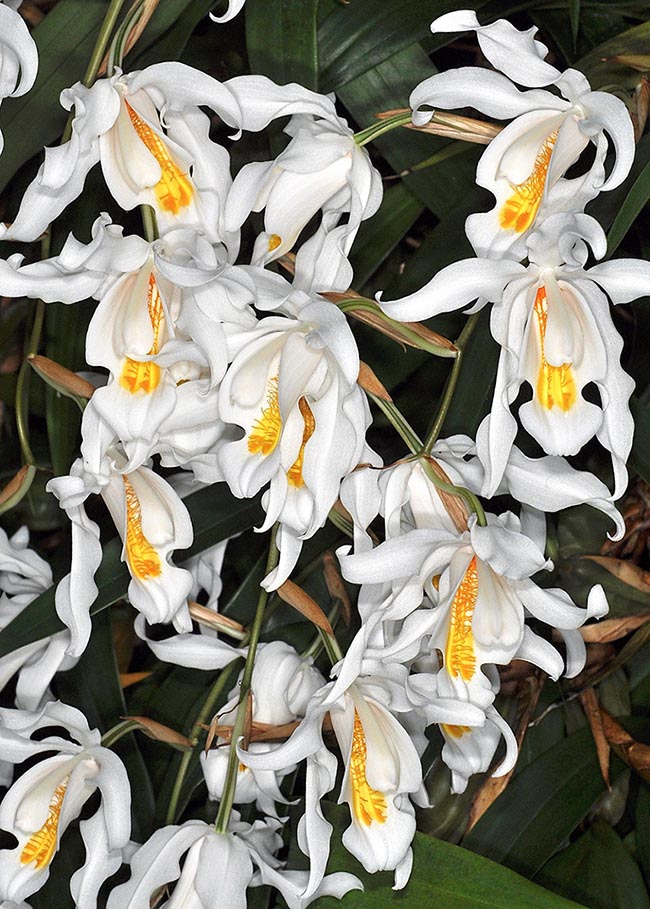
It grows as epiphyte or lithophyte in mossy forests from 1600 to 2600 m of altitude © Ron Parsons
It is a species living in a rather cold environment and only a few other species such as Coelogyne corymbosa Lindl. and Coelogyne stricta (D. Don) Schltr. have been found at higher altitudes between 2.800 and 3.000 metres, where, in winter, are covered with snow and are also exposed to intense cold (frost).
The genus Coelogyne has been described by John Lindley (1799-1865) basing on a plant coming from Nepal that he named Coelogyne punctulata Lindl.
This genus distinguishes from the other similar orchids because having the dorsal sepal, over the labellum, concave, the labellum trilobate, with the erect lateral lobes on the sides of the column, and 4 or 5 fimbriate lamellae (keels) extending for most of the median lobe.
The name comes from the Greek words κοίλος (koílos) “empty, hollow” and γῠνή gyné “woman” meaning feminine due to the hollow shape of the upper part of the pistil (stigma).
Coelogyne cristata was collected in Nepal by Dr. Nathaniel Wolff Wallich (1786-1854), who, by that time, was the director of the Botanical Garden of Calcutta and was introduced in England in the greenhouses of the gardens of Chatsworth (Derbyshire), in that time considered as incomparable due to the number of species.
Lindley described it in the publication Collectanea botanica (Coll. Bot. 7: sub t. 33 (1821), however it is to be reported that despite the description and the relevant plate no. 33 is dated 1821, verifications within the opus show that could not have been published before 1824.
The specific name cristatus refers to the combs located on the labellum. Commonly it is called “Snow Queen, Crested Snow Orchid”.
Coelogyne cristata is an epiphytic, and also lithophytic, herbaceous plant. It has a creeping or slightly pendulous rhizome, rather rigid, of 4-6 mm of diameter, ramified, with thick sheaths glossy, coriaceous, scaly. On the rhizome take form pseudobulbs spaced 1,5-3 cm , of ovoid or cylindrical shape, usually covered by coriaceous sheaths, generally with two leaves at the apex, at times with one leaf only.
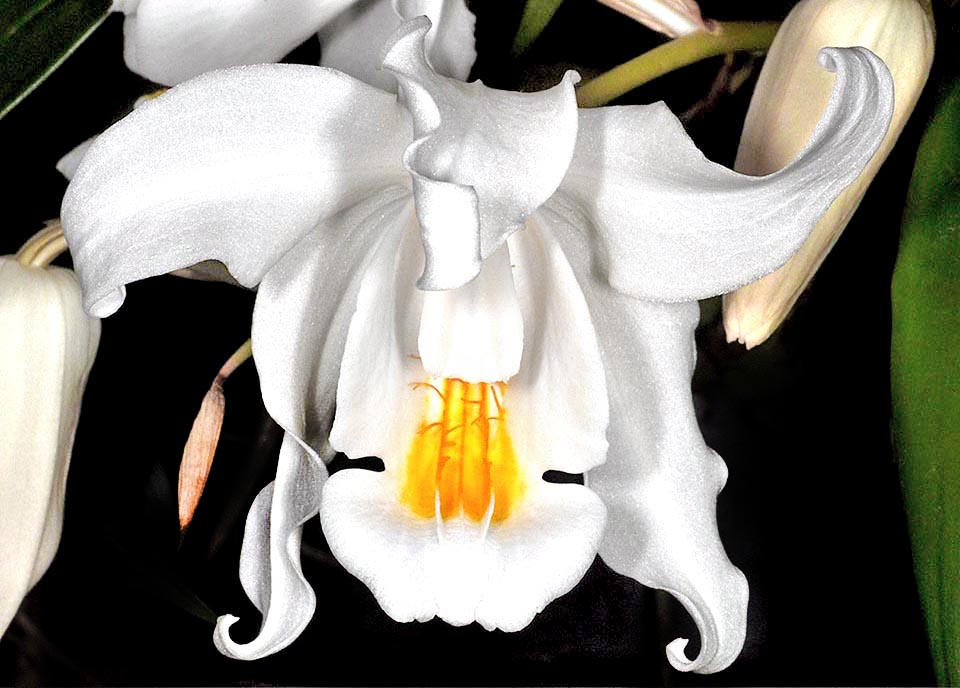
The scented flowers have lanceolate 3-4 cm long sepals and petals. The labellum has typical parallel crests © Ron Parsons
The foliar lamina, of intense green colour, measures 10-17 x 0,7-1,9 cm of oblong or elliptic shape with the base attenuated on a short petiole.
From the base of the pseudobulb originates the 8-12 cm long racemose inflorescence, with the basal half wrapped by sheaths. It bears 2 to 10 flowers, pale yellow when in bud, but when open of a very nice white colour, with yellow crests in the central part of the labellum.
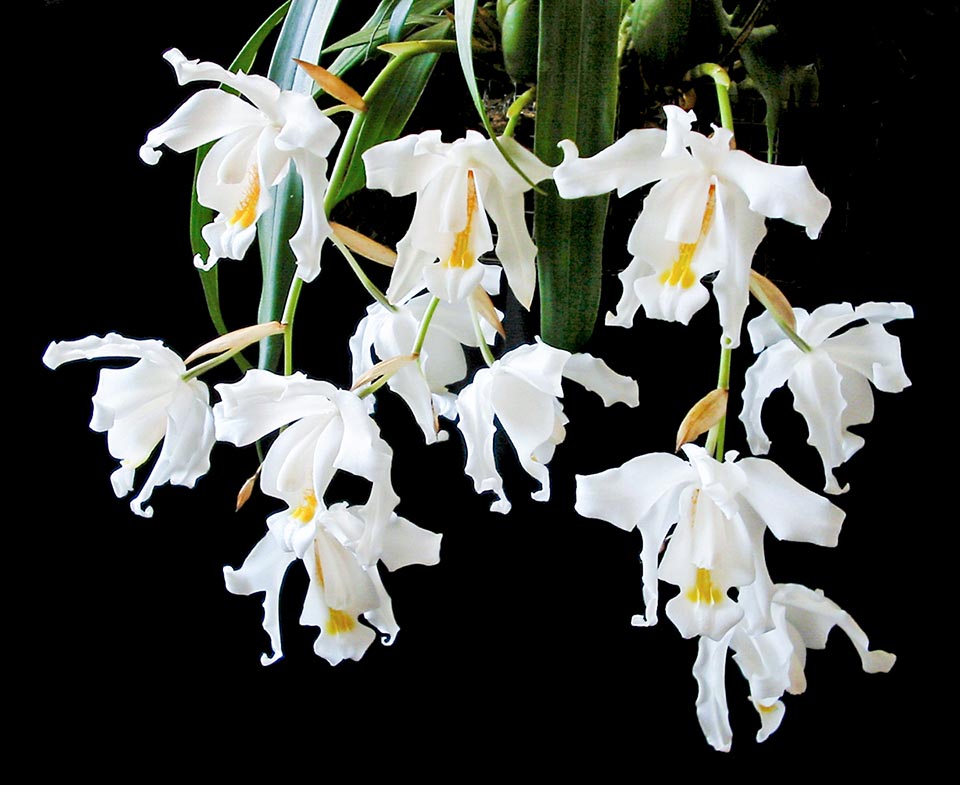
These, usually yellow, in elegant contrast to the snowy white of the flowers, are formed by 4-5 fimbriate lamellae © Ignas Stanevičius
The floral bracts do not fall at the anthesis and are ovate) lanceolate, 2,5-3,5 cm long. The flowers, resupinate, are quite big and scented. The sepals are lanceolate or oblong-lanceolate, 30-40 x 10-15 mm, with sharp apex.
The lateral petals are similar to sepals, 9-11 mm broad, and the labellum, 12-15 mm, is concave, trilobate with erect lateral lobes, sub-ovate, almost entire, and medium lobe widely obovate, with almost entire margin.
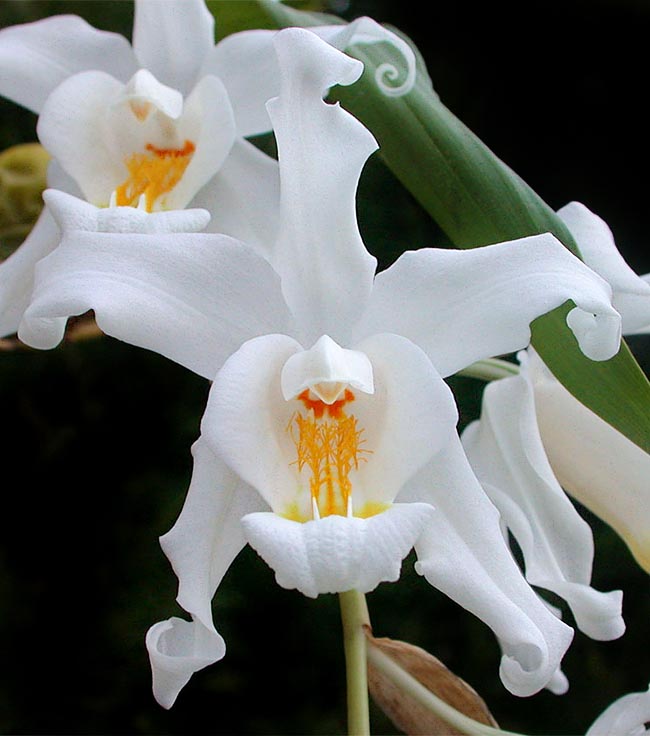
The two lateral ones are crenulate, similar to plates and the median is continuous and prominent © Sylvain Burgaud
In the labellum are present 4-5 fimbriate lamellae that extend from the base up to the medium lobe.
The two inner lateral ones are crenulate, similar to plates and the median lamella is continuous and prominent.
The column is slightly arcuate, 20-30 mm, with wings on both sides widening from the base to the sub-truncate apex.
Blooming occurs in spring, before the snow begins to melt and lasts several weeks.
The fruit is a medium-sized capsula, often with ribs.
The chromosome number is 2n=40.
The photosynthesis is of CAM type (Crassulacean Acid Metabolism), carried out as an adaptation to the excessive loss of water (xerophytic adaptation).
In this way the process of photosynthesis takes place with closed stomata that, conversely, open during the night for the gassy exchanges (CO2, O2)with a minimum waste of water vapor.
Coelogyne cristata reproduces by seed or by division of the rhizome but in such a way that each section is provided with at least 3-4 pseudobulbs.
It may also reproduce in vitro with formation of protocorms by means of the germination in immature seeds from green fruits. With this germination technique of the asymbiotic seeds is increased the percentage of germination without the complexities of the relation host-fungus and also is reduced the interval between the pollination and the maturation of the seeds.
At the beginning of the XX century this species has met a certain success in the collections and in the cut flowers market due to their characteristic of lasting from four to six weeks available in the northern hemisphere from December to May with a peak in February and in March.
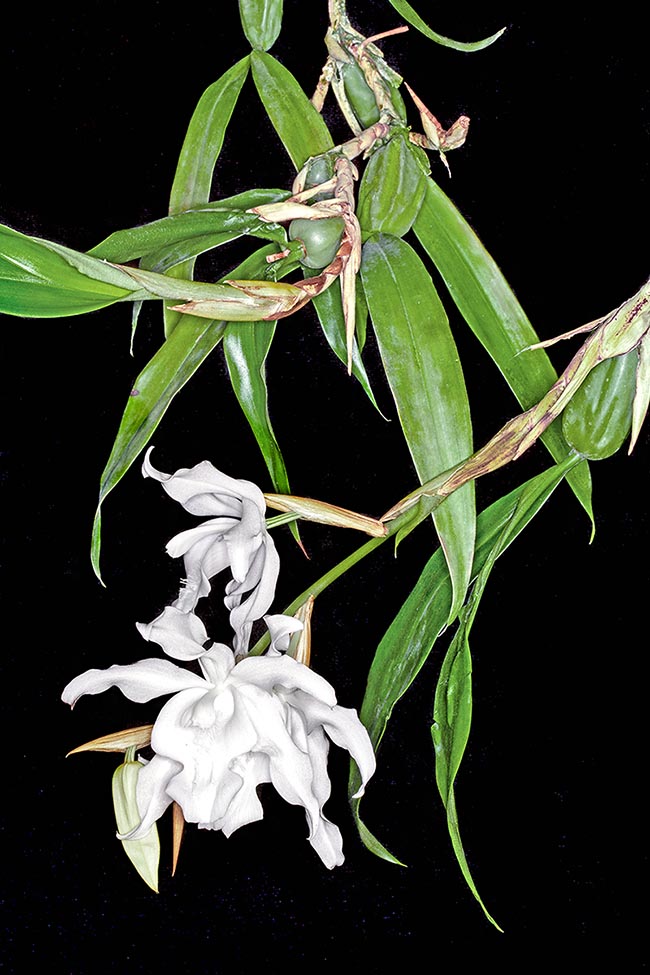
The creeping or lightly pendulous rhizome, rather rigid, of 4-6 mm of diameter, has ovoid or cylindrical pseudobulbs, with usually two intense green leaves that may reach even 17 cm of length. Here a Coelogyne cristata alba © Giuseppe Mazza
Presently it is mainly cultivated by specialized growers because the non professional orchidophiles consider it, wrongly, as a species difficult to cultivate.
In the United Kingdom, this species has gotten the Award of Garden Merit by the Royal Horticultural Society.
Apart from the natural hybrid, Coelogyne granulosa, obtained by crossing in nature between Coelogyne cristata × Coelogyne albolutea, do exist several hybrids of this species obtained by crossing between
Coelogyne cristata and other species of the same genus.
At times these are orchids considerably superior to the same species of origin.
As of 2020 following hybrids have registered at the Royal Horticultural Society of Kex Gardens (London):
Coelogyne Colmanii, Colman 1907 (Coelogyne cristata × Coelogyne speciosa subsp. incarnata);
Coelogyne Cosmo-Crista, Kokusai 1996 (Coelogyne Intermedia × Coelogyne cristata);
Coelogyne Intermedia, Cypher 1913 (Coelogyne cristata × Coelogyne tomentosa);
Coelogyne K.R. Gessert, M.Karge-Liphard 2014 (Coelogyne cristata × Coelogyne usitana);
Coelogyne Linda Buckley, R.Hull 1989 (Coelogyne mooreana × Coelogyne cristata);
Coelogyne Louanne Banks, Hills Dist. 2015 (Coelogyne Unchained Melody × Coelogyne cristata);
Coelogyne Memoria Fukuba, Suwada Orch. 2001 (Coelogyne Shinjuku × Coelogyne cristata);
Coelogyne Noel Wilson, Geyserland 1984 (Coelogyne mossiae × Coelogyne cristata);
Coelogyne Orchideengarten Marei, M.Karge-Liphard 2014 (Coelogyne xyrekes × Coelogyne cristata);
Coelogyne Unchained Melody, David Banks 1995 (Coelogyne cristata × Coelogyne flaccida).
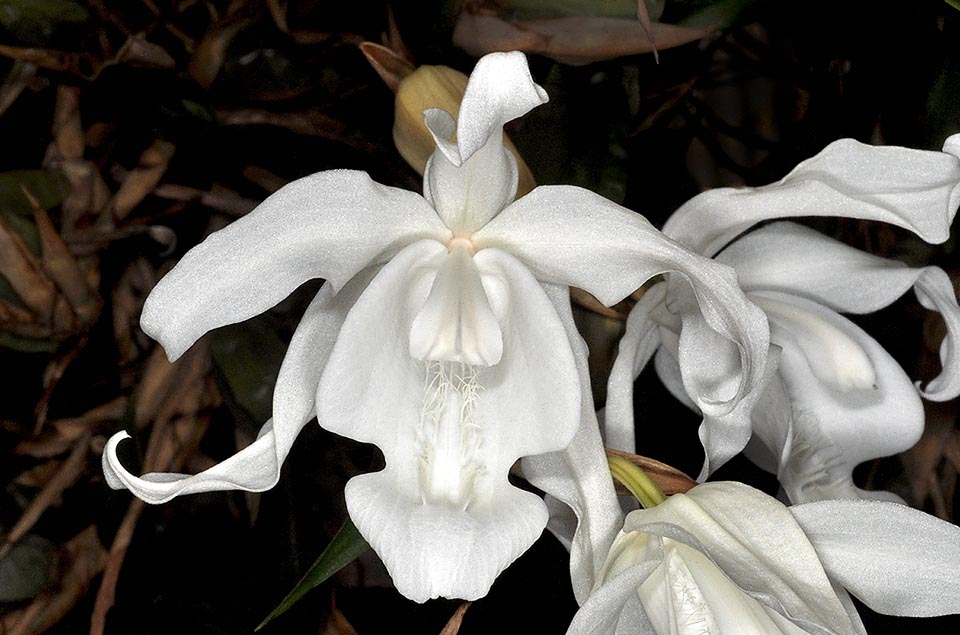
Coelogyne cristata f. hololeuca has originated many cultivars, often awarded in the contests © Ron Parsons
This last hybrid has an intermediate growth and since some time has been cultivated but mistaken with Coelogyne
mossiae Rolfe (1894), a rare Indian species, to which it superficially resembles.
The difference stands in the number of lamellae that are two, entire, in Coelogyne mossiae and three slightly wavy and deeply fimbriate at the base in the hybrid.
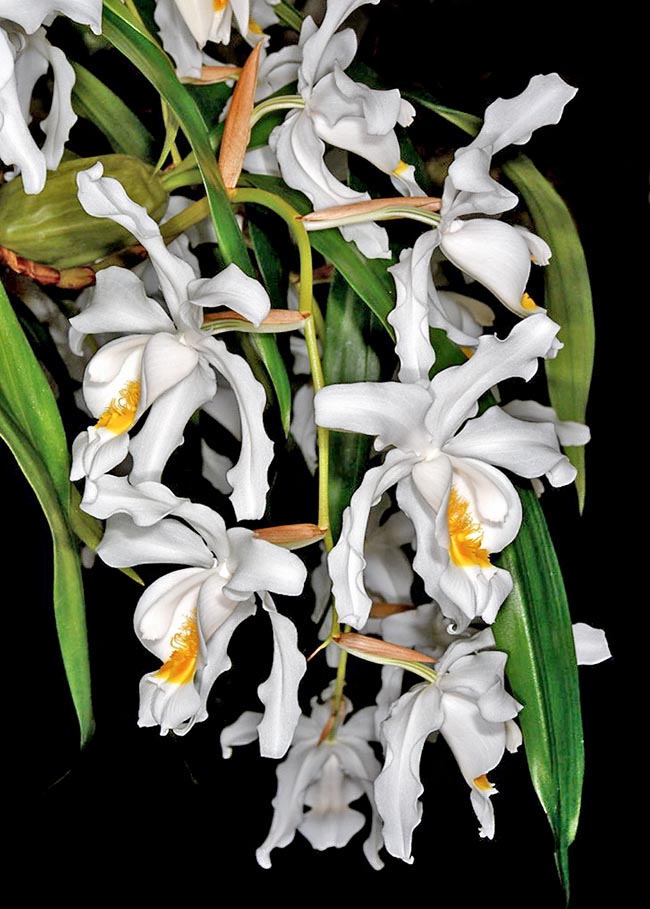
Coelogyne cristata ‘The Queen’ has won 4 awards from 1982 to 2018 © Ron Parsons
Most awarded/recent cultivars:
Coelogyne cristata ‘Wössen’ (16 awards from 2010 to 2017); Coelogyne cristata ‘The Queen’ (4 awards from 1982 to 2018); Coelogyne cristata var. hololeuca ‘Wössen’ (4 awards from 2013 to 2018); Coelogyne cristata var. hololeuca ‘Wössen II’ (2 awards in 2017); Coelogyne cristata var. hololeuca ‘Maria’ (2 awards in 2017); Coelogyne cristata ‘Martin’ (2 awards in 2016);Coelogyne cristata h.f. alba ‘Harald’ (2 awards in 2015); Coelogyne cristata f. hololeuca ‘Wössen’ (2 awards in 2015); Coelogyne cristata ‘Sternberg’ (2 awards 2014); Coelogyne cristata ‘Helga’ (2 awards in 2013); Coelogyne cristata ‘Weihe’ (2 awards in 2012); Coelogyne cristata‘Jardin Botanique de Montreal’ (2 awards in 2011); Coelogyne cristata ‘Harley’s Pride’ (2 awards in 2002); Coelogyne cristata ‘Stirling’ (2 awards in 1996); Coelogyne cristata ‘Orchid Hill’ (2 awards from 1971 to 1974); Coelogyne cristata ‘Walter’ (2018); Coelogyne cristata ‘Barbarossa’ (2018); Coelogyne cristata ‘Dresda’ (2017); Coelogyne cristata h.f. alba ‘Wasserwerk’ (2017); Coelogyne cristata ‘Gunter’ (2015).
Coelogyne cristata, renowned for its magnificent flowers and the long lasting fragrance, may be also cultivated indoors and the passionates are enticed by the sheer quantity of white and golden inflorescences.
The plants grow better if behind a window but the direct sun must be avoided.
The temperatures must never exceed 23 °C.
It must be kept in mind that in winter, in the origin countries, the temperature is 13-16 °C during the day and 7-10 °C during the night.
In summer they can be left outdoors in partial shade, but if the temperature is too high, the risk is of not seeing them in flower.
The humidity to be preferred is 70-85% during the spring and summer growth and around 50-60% during the winter resting time.
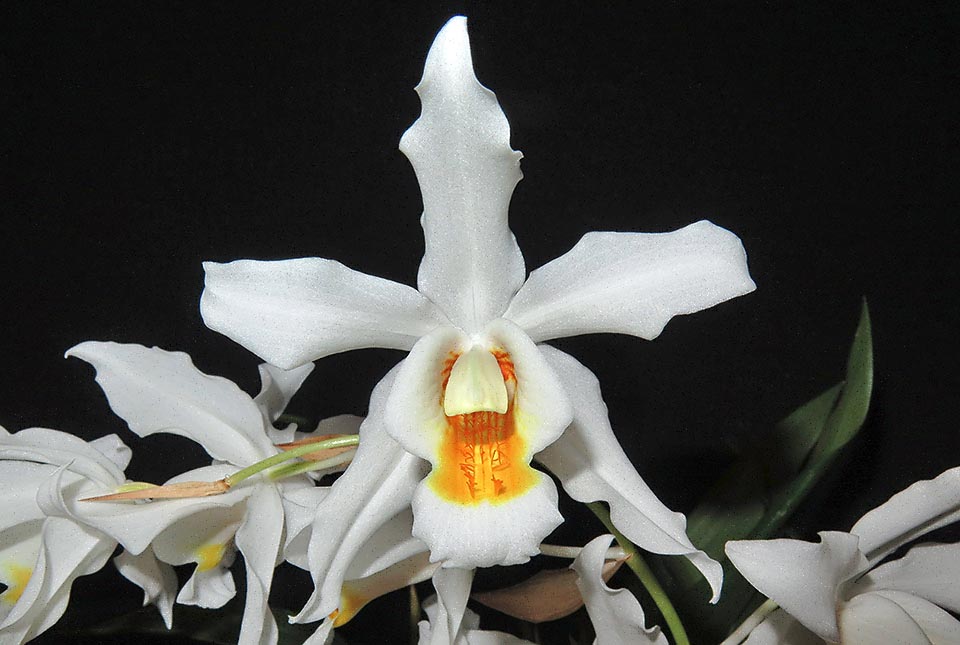
Coelogyne Linda Buckley comes from the crossing of Coelogyne mooreana with Coelogyne cristata © Jaroslav Jirásek
A humidifier for cold spaces is sufficient.
For the best growth it is good to create a good movement of air. During their period of active growth, tha plants are to be watered abundantly keeping the soil mix always humid whilst during the resting time (about six weeks) giving water sufficient to avoid that the mix dries up.
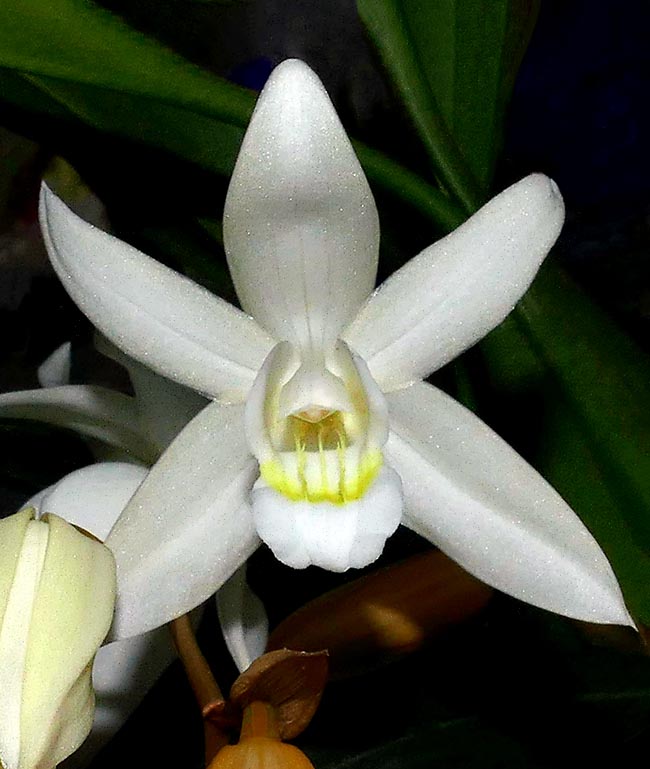
The cross Coelogyne cristata × Coelogyne tomentosa has originated Coelogyne Intermedia, and this, with Coelogyne cristata, has then generated Coelogyne Cosmo-Crista. The adventure goes on supported by the horticultural interest © Nolehace Photography
When watering it is very important that the buds and the developing flowers are maintained dry.
Even a few drops of water on the flowers may cause unsightly brown-coloured spots, spoiling what otherwise might be a spectacular blooming.
Not even the pseudobulbs should be wet, actually, it’s better to immerse the container in warm water under the level of the new growth for ten minutes instead of watering from above.
The leaves can be sticky and this is normal for the plants of this genus.
It is suggested to wash them using warm water.
During the growth stage a foliar fertilizer is to be applied every two or three waterings whilst no fertilizations are to be done during the rest time.
The containers (pots or hanging baskets) are to be filled up with a mix suggested for the orchids like, for instance, with bark (maritime pine or fir bark resin-free or sterilized) of medium size (9-12 mm) or small (6-9 mm), with addition of perlite, sphagnum and charcoal.
Tree fern fibre may also be used with about 10% of fine charcoal, 10% of perlite or spongy rock and 10% of added chopped sphagnum.
The plants may be also stuck to slabs of cork or of tree fern, with sphagnum moss, in this way a better effect is obtained because the pendulous inflorescences are exalted.
Repotting is to be done only if necessary and if the pot is full of roots, in any case not before four years because these plants grow well if left undisturbed.
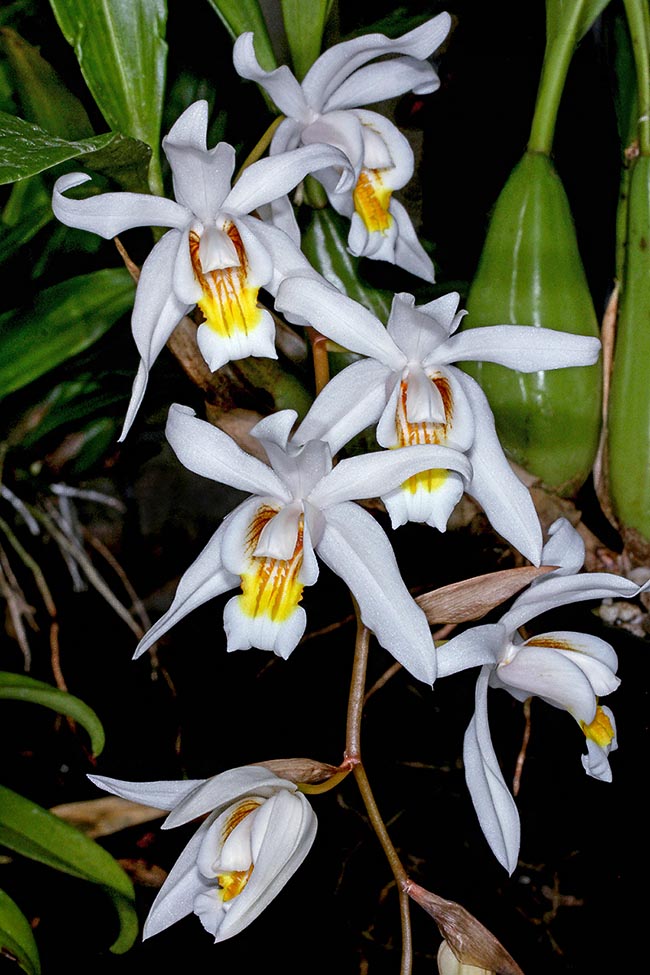
So, similarly, Coelogyne Unchained Melody, born from Coelogyne cristata x Coelogyne flaccida, has created, with Coelogyne cristata, Coelogyne Louanne Banks. Infinite beauty, without counting the medicinal virtues of the species © John Varigos
The best period for repotting is spring or just after the end of blooming.
If one wants to propagate the plant the rhizome must be cut leaving at least a new pseudobulb and two or three old ones.
If during the growth the leaves present the distal part brown, this is possible as the cause may be the dry soil, the dry air or the tap water containing fluorine, chlorine and salts that accumulate in the growth substrate.
In this case it is to be utilized distilled or rain water and increase the humidity if the air is too dry.
It can also be caused by the root rot coming from too much water on old and degraded land.
If the damage is reversible, the old substratum can be removed, cleaned and treated the sick part of the plant with an antifungal and repot it utilizing a new substratum and a clean pot.
This plant is very resistant to diseases however it may be attacked by the mealybug or subject to fungal diseases to the leaves that can be eradicated with common fungicides.
Coelogyne cristata is a species with bone healing properties that are widely practiced by the natives of Kumaon Himalaya (India).
The active principles stand in the pseudobulbs and have good effects also in the nervous disorders, in headache, in epilepsy, in the tremors, etc.
The natives of some remote villages of the Almora district in the state of Uttarakhand (India) apply the resin extracted from the fruits on the wounds of the body to make the blood of people or of animals clot.
The pseudobulbs infusion is also used by the doctors of Uttarakhand as aphrodisiac and to get relief from chronic constipation. Coelogyne cristata has also anti-aging and anti-stress properties.
Synonyms: Coelogyne cristata f. hololeuca (Rchb.f.) M.Wolff & O.Gruss (2007); Coelogyne cristata var. hololeuca Rchb.f. (1881); Cymbidium speciosissimum D.Don (1825); Pleione speciosissima (D.Don) Kuntze in Revis. (1891).
